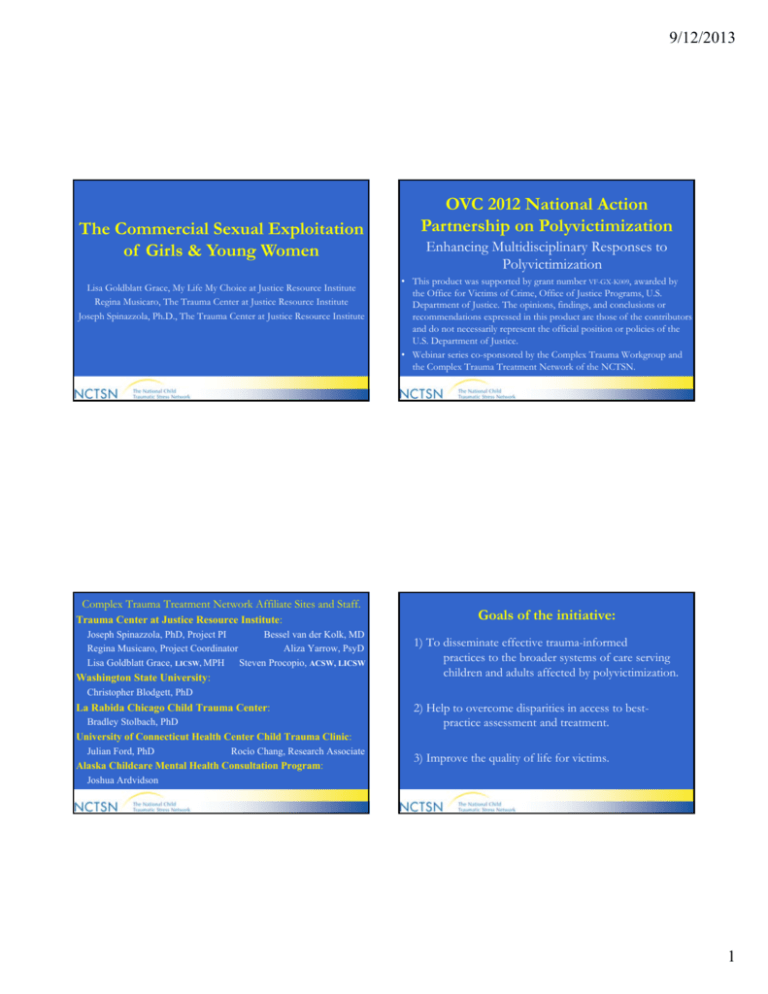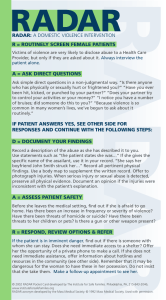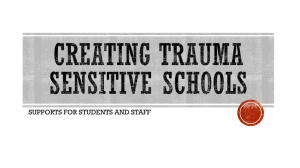
9/12/2013
The Commercial Sexual Exploitation
of Girls & Young Women
Lisa Goldblatt Grace, My Life My Choice at Justice Resource Institute
Regina Musicaro, The Trauma Center at Justice Resource Institute
Joseph Spinazzola, Ph.D., The Trauma Center at Justice Resource Institute
Complex Trauma Treatment Network Affiliate Sites and Staff.
Trauma Center at Justice Resource Institute:
Joseph Spinazzola, PhD, Project PI
Bessel van der Kolk, MD
Regina Musicaro, Project Coordinator
Aliza Yarrow, PsyD
Lisa Goldblatt Grace, LICSW, MPH Steven Procopio, ACSW, LICSW
Washington State University:
OVC 2012 National Action
Partnership on Polyvictimization
Enhancing Multidisciplinary Responses to
Polyvictimization
• This product was supported by grant number VF-GX-K009, awarded by
the Office for Victims of Crime, Office of Justice Programs, U.S.
Department of Justice. The opinions, findings, and conclusions or
recommendations expressed in this product are those of the contributors
and do not necessarily represent the official position or policies of the
U.S. Department of Justice.
• Webinar series co-sponsored by the Complex Trauma Workgroup and
the Complex Trauma Treatment Network of the NCTSN.
Goals of the initiative:
1) To disseminate effective trauma-informed
practices to the broader systems of care serving
children and adults affected by polyvictimization.
Christopher Blodgett, PhD
La Rabida Chicago Child Trauma Center:
Bradley Stolbach, PhD
University of Connecticut Health Center Child Trauma Clinic:
Julian Ford, PhD
Rocío Chang, Research Associate
Alaska Childcare Mental Health Consultation Program:
Joshua Ardvidson
2) Help to overcome disparities in access to bestpractice assessment and treatment.
3) Improve the quality of life for victims.
1
9/12/2013
II. Understanding Polyvictimization
Types of Victimizations
Examples:
• Definition: exposure to multiple forms of maltreatment or
violence. Papers vary in exposure criteria (Ford et al., 2011):
• Categorically defined— 3 of 10 adverse child experiences ACEs
(Anda et al., 2006); 4 of 34 types of victimization within the past year
and quantified by levels of exposure. low: 4-6 types, high: 7 ≤ types
(e.g., Finkelhor, Ormrod, & Turner, 2007, 2009).
Dimensionally Defined—Number of types of victimization from a list
of between 3 and 10 specific exemplars for each of several victimization
categories (Elliott et al., 2009).
• Statistical techniques—Analyses designed to identify subgroups based
on profiles of variables of interest (Ford et al., 2009).
-Sexual abuse
-Physical abuse
-Neglect
-Emotional abuse
-Verbal abuse
-War
-Oppression
-Terrorism
-Rape
-Assault
-Dating Violence
-Robbery
-Witness to Murder
-Ethnic Cleansing
-Loss through violent death,
exposure to shootings, street violence, etc.
-Commercial sexual exploitation/human trafficking
-Custodial Interference/Family Abduction
Polyvictimization Prevalence
• Polyvictimization is pervasive problem in the US
- 10-25% in the general population.
- E.g. In a nationally representative sample of 2,000 children,
22% were victims of 4+ types of victimization in past year
(Finkelhor, Ormrod, and Turner, 2007).
-5-55% in high risk or clinical samples.
-E.g. In an inpatient child psychiatric sample Ford et al. (2009)
found 55% who had multiple types of adversity.
*Different papers use different category lists. Therefore, we
cannot make comparisons without considering the number of
exposure categories endorsed in relation to the total number of
categories listed.
• Child polyvictims
are more distressed
than children who
experience repeated
instances of one type
of victimization
D., F., H., T., S., H., & R., O. (n.d). National Survey of Children's Exposure to Violence. Polyvictimization: Children's
Exposure to Multiple Types of Violence, Crime, and Abuse. Juvenile Justice Bulletin. NCJ-235504.
2
9/12/2013
III. Understanding Complex Trauma
Finkelhor, Ormrod, Turner, and Holt (2009) study cited in D., F., H., T., S., H., & R., O. (n.d). National Survey of
Children's Exposure to Violence. Polyvictimization: Children's Exposure to Multiple Types of Violence, Crime, and
Abuse. Juvenile Justice Bulletin. NCJ-235504 .
• Definition: children’s exposure to multiple traumatic
events, often of an invasive, interpersonal nature, and the
wide-ranging, long-term impact of this exposure (Cook et
al., 2005).
• The complex trauma construct emphasizes the range
and depth of short and long-term effects of
polyvictimization in children and adults.
• 70.4% of 2,251 youth in foster care in NCTSN sample
experienced two or more types of interpersonal
victimizations by caregivers (physical abuse, sexual abuse,
emotional abuse, neglect, domestic violence). 11.5%
reported all five (Greeson, J.K.P. et al., 2011).
Complex Trauma Domains of Impact
Complex Trauma in NCTSN Sample
Of 1,699 NCTSN children
77.6% had been exposed to
multiple and/or prolonged
trauma.
Rest of Sample
Multiple and/or
prolonged
Spinazzola, J., Ford, J. D., Zuzker, M., van der Kolk, B., Silva, S., Smith,
S., Blaustein, M. (2005) Survey evaluates complex trauma exposure,
outcome and intervention among children and adolescents, Psych Annals,
35(5) 433-439.
I. Attachments and Relationships
• II. Physical Health: Body and Brain
• III. Emotional Responses
• IV. Dissociation
• V. Behavior
• VI. Cognition: Thinking and Learning
• VII. Self-Concept and Future Orientation
Cook, A., Spinazzola, J., Ford, J. D., Lanktree, C., Blaustein, M., Cloitre,
M. t al. (2005). Complex Trauma in Children and Adolescents, Psychiatric
Annals, 35(5) 390-398.
3
9/12/2013
75%
-Spinazzola, J., Ford, J. D., Zuzker, M., van der Kolk, B., Silva, S., Smith, S., Blaustein, M.
(2005). Survey evaluates complex trauma exposure, outcome and intervention among
children and adolescents, Psych Annals, 35(5) 433-439.
Percent With Health Problem (%)
25
Polyvictimization is associated with
Complex Trauma in Adulthood.
ACE Score
20
0
1
2
3
4 or more
45%
30%
15%
0%
Spinazzola, J., Ford, J. D., Zuzker, M., van der Kolk, B., Silva, S., Smith, S., Blaustein, M.
(2005) Survey evaluates complex trauma exposure, outcome and intervention among children
and adolescents, Psych Annals, 35(5) 433-439.
Odds for Problems with Increasing ACEs after
Controlling for Other Risks.
Academic
Failure
Severe
Attendance
Problems
Severe School
Behavior
Concerns
Frequent Reported
Poor
Health
3
5
6
4
Two ACEs
N=213
2.5
2.5
4
2.5
One ACE
N=476
1.5
2
2.5
2
No Known ACEs
=1,164
1.0
1.0
1.0
1.0
15
10
Three or More
ACEs N =248
5
0
Alcohol Abuse
Attempted
Suicide
Anxiety
Kessler National Comorbidity Survey reported in: Anda, R. F., Felitti, V. J., Bremner, J. D., Walker, J. D., Whitfield, C.,
Perry, B. D., . . . Giles, W. H. (2006). The enduring effects of abuse and related adverse experiences in childhood.
European Archives of Psychiatry and Clinical Neuroscience, 256, 174-186.
S
O
ub
th
er
st
an
ce
U
se
NCTSN Sample (N=1699)
-Early exposure: 93% had 1st trauma by age 8; 98% by age 11.
-50% or more of exposed children had clinical disturbances in:
affect regulation
attention and concentration
negative self image
impulse control
aggression
risk-taking
Complex Adaptation to Polyvictimization
60%
A
ffe
ct
D
ys
Im
re
pu
g.
ls
e
C
N
o
eg
nt
r
.S
ol
el
f-I
m
ag
C
on
e
ce
nt
ra
tio
n
A
gg
re
ss
io
C
n
on
du
S
ct
ex
d/
ua
o
lP
ro
bl
e
m
S
om
s
at
iz
at
io
n
C
lin
gi
ne
E
m
ss
ot
.D
et
ac
D
h
is
so
ci
at
io
n
S
oc
ia
lA
nx
.
Early Life Trauma Exposure is Associated
with Complex Trauma Symptoms.
4
9/12/2013
0
8
6
4
2
e
H
ep
at
iti
s/
Ja
un
di
c
Sk
el
et
al
Fr
ac
.
D
ia
be
te
s
0
B
ro
nc
h.
/E
m
ph
.
• 45% were physically abused as children by a family member
• 34.5% were sexually abused as children by a family member.
• 14.8% were sexually abused by a stranger.
4 or more
10
St
ro
ke
• Very high rates of polyvictimization and complex trauma are
found in samples of incarcerated adults (Carlson et al., 2010).
Percent With Health Problem (%)
• Lower levels of economic wellbeing: Adults with histories of
childhood neglect and/or abuse earn $5,000 less per year than
control subjects (Currie & Widom, 2010).
Polyvictimization in Childhood Leads to Premature Death in
Adulthood.
ACE Score
12
N=9,508)
H
ea
rt
D
is
ea
se
Childhood Maltreatment is associated with
Adult Failure in Society.
Felitti, V. J., Anda, R. F., Nordenberg, D., Williamson, D. F., Spitz, A. M., Edwards, V., Koss, M. P., Marks, J.
S. (1998). Relationship of Childhood Abuse and Household Dysfunction to many of the Leading Causes of
Death in Adults. American Journal of Preventative Medicine, 14(4) 245-258.
Economic Cost of Childhood Maltreatment
• Over $124 billion in costs/year (Fang et al., 2012)
– Similar findings to prior study: Pew Charitable Trusts Study (Wang & Holton,
2007): 104 billion per year. Direct Costs: 34 billion; Indirect: 70 billion
• Lifetime cost per victim of nonfatal child maltreatment is $210,012:
-$144,360 productivity losses
-$7,728 child welfare costs
-$6,747 criminal justice costs
-$7,999 special education costs
-$32,648 childhood health care costs
-$10,530 adult medical costs
• A conservative sensitivity analysis, estimated total burden to be as large
as $585 billion.
What is CSEC?
The commercial sexual exploitation of children (CSEC) comprises:
• Sexual abuse and remuneration in money, goods, or services; or the promise of money, goods, or services
• Defined by an element of organization and/or intent; and/or the context of the commercial sex industry
• The child is treated as a commercial and sexual object
• CSEC is a form of violence against children
5
9/12/2013
CSEC Includes…
•
•
•
•
•
•
•
•
•
•
Street prostitution
Pornography
Stripping
Erotic/nude massage
Escort services
Phone sex lines
Private parties
Gang-based prostitution
Interfamilial pimping
Forms of Internet-based exploitation
Maria
On our community
On victims’ mind, body and soul
Harnessing Girls’ Strength, Resilience and Outrage | 22
Domestic Minor Sex Trafficking
TVPA of 2000 defines “severe forms of trafficking in persons” in the
following two-tiered definition:
•
•
CSEC in the United States
• At least 100,000 to 300,000 youth are at risk for
commercial sexual exploitation annually in the U.S.
Sex trafficking in which a commercial sex act is induced by force, fraud, or
coercion, or in which the person induced to perform such an act has not
attained 18 years of age; or,
The recruitment, harboring, transportation, provision, or obtaining of a person
for labor or services, through the use of force, fraud, or coercion for the
purposes of subjection to involuntary servitude, peonage, debt bondage, or
slavery.
• The most frequent age of entry into the commercial sex
industry in the U.S. is between 12-15 years old.
6
9/12/2013
Who is at risk?
Girls at risk for recruitment into CSEC are girls who:
•
•
•
•
•
•
•
•
•
•
•
Are under 18 years old
Walk to school or the store alone
Own or have access to a computer
Are attached to consumer goods
Desire to develop romantic relationships
Sometimes feel insecure
Feel misunderstood
Fight with their parents
Sometimes feel their parents don’t care
Want more independence
Test boundaries and take risks
According to this, who is at risk for recruitment into CSEC?
Laura
Barbra
On our community
On victims’ mind, body and soul
Harnessing Girls’ Strength, Resilience and Outrage | 28
7
9/12/2013
Multiple studies indicate that
70-90%
of girls and women in the Life
have a history of
child sexual abuse.
Other forms of victimization that increase
risk:
Physical and emotional abuse
Witnessing domestic violence
Parental addiction
Loss or abandonment of parent
Poverty
Racism & Sexism
Jenna
On our community
How do pimps recruit girls and
“turn them out?”
On victims’ mind, body and soul
Harnessing Girls’ Strength, Resilience and Outrage | 31
8
9/12/2013
Psychological/Emotional Impact of CSEC
Disruption of healthy psychological development
Self-concept, intimacy, beliefs and goals
Post Traumatic Stress Disorder (PTSD)
Impulse to revisit traumatic events,
intrusive emotions & memories, flashbacks, hyper arousal,
exaggerated startle reaction, panic symptoms
Self-injurious and suicidal behavior
Dissociative disorders
Anxiety
Paranoia
Clinical depression
Explosive outbursts
Sleep disturbance & nightmares
Bond with perpetrators
Hyper-sexualization
Spiritual Impact of CSEC
Despair
Hopelessness
Lack of belief in humanity
Lack of faith in spiritual power
Physical Impact of CSEC
Social Impact of CSEC
Emotional Impact of CSEC
Anger and rage
Deep emotional pain/grieving
Feelings of humiliation/shame
Stigma of exploitation
Self-blame/Self-loathing
Loss of sexual desire, feelings, or response
Created by GEMS
Continuous physical abuse
Rape & gang rape
STDs & STIs
HIV & AIDS
Loss of bowel control
Pregnancy (wanted and unwanted)
Sterility
Facial/dental reconstruction
Tattoos & branding
Brain damage
Substance abuse/addiction
Self-cutting
Suicide/Death
Isolation from peer group
Disconnection from community
Isolation from mainstream society
Homelessness
Incarceration/Criminal record as obstacle
Disempowerment
Lack of life skills
Trust issues/Difficulty maintaining relationships
Obstacles to vocation
Lack of access to legal economies, lack of job experience/skills
Educational deprivation
Missed school, disconnection with school system
If the violence and abuse are this
severe,
why don’t children just leave or call
out for help?
Stockholm Syndrome
Biderman’s Chart of Coercion
"Most people who brainwash...use methods similar to those
of prison guards who recognize that physical control is never
easily accomplished without the cooperation of the prisoner.
The most effective way to gain that cooperation is through
subversive manipulation of the mind and feelings of the
victim, who then becomes a psychological, as well as a
physical, prisoner."
--from an Amnesty International publication, "Report on Torture"
the psychological tendency of a hostage
to bond with, identify with, or
sympathize with his or her captor
from a 1973 robbery attempt in Sweden,
during which bank employees held
hostage developed sympathetic feelings
toward their captors
--Merriam Webster Dictionary
9
9/12/2013
What are the major indicators of trauma bonding?
Stockholm Syndrome and Trauma Bonds
What needs to be present for Stockholm Syndrome to occur?
•
•
•
•
A perceived threat to one’s physical or psychological survival
A perceived small kindness from the abuser to the victim
Isolation
The perceived inability to escape
•
•
•
•
•
•
•
Shows ongoing symptoms of trauma or PTSD
Intensely grateful for small kindness
Denies violence
Rationalizes violence
Denies anger at exploiter
Believes they have some control over abuse
Self-blame for situation and abuse
What are the major indicators of trauma bonding?
(cont’d)
•
•
•
•
•
•
•
•
•
Hyper vigilant to exploiter’s needs
Seeks to keep exploiter happy
Tries to get inside pimp’s head
Sees world from exploiter’s perspective
Experiences sense of self through pimp’s eyes
Sees outside authorities/providers as bad guys
Sees pimp as good guy, protector
Sees exploiter as victim
Is thankful and grateful that pimp has not killed her
ASK:
Have you ever had to exchange sex for
money, food, drugs, or shelter?
10
9/12/2013
RED FLAGS
•
•
•
•
•
She has visible signs of abuse.
She has behaviors consistent with complex trauma.
You note a change in her physical appearance.
She has a tattoo which she is reluctant to explain.
She appears exhausted.
RED FLAGS
• She is frequently truant from school.
• She has an interest in pornography or other parts of the
sex industry.
• She has new friends.
• She is disconnected from her family or other caregivers.
• She has lost interest in age appropriate activities.
RED FLAGS
• She has unexplainable absences from her home or
residential program.
• She has one or multiple cell phones.
• She uses language from “the Life”.
• She is involved with a male who is…
• She has a history of multiple Sexually Transmitted
Infections and/or pregnancies.
• She spends an inordinate amount of time on line.
Responding to victims
• Immediate:
– Psychological First Aid
• Next Steps:
– Protocol for Responding to Disclosures
11
9/12/2013
Types of Referrals
Child Protection
vs. Recovery/Empowerment
Questions?
•
•
•
•
•
•
•
•
Child Protective Services
Shelter/housing
Basic needs met/safety
Support
Mental health services
Legal services
Substance abuse treatment
Educational plan/support
For Furthermore Information
• Visit our website:
“My Life My Choice is the
gold standard in prevention
and mentoring programs
for commercially sexually
exploited and trafficked
girls.”
RACHEL LLOYD
EXECUTIVE DIRECTOR Girls Educational and Mentoring Services
Lisa Goldblatt Grace
Director
617.699.4998
lgrace@jri.org
http://www.traumacenter.org/initiatives/Polyvictimization.php
• Call the Technical Assistance Line:
(617) 232-1303, x330
www.fightingexploitation.org
www.facebook.com/mylifemychoice
• Email the project coordinator:
Regina Musicaro at rmusicaro@jri.org.
12










